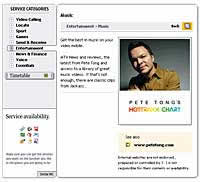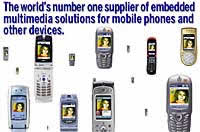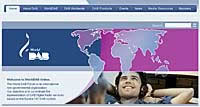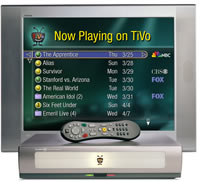 UK 3G operator 3, proudly trumpeted the fact that more than 10 million music videos have been watched by its customers on their mobiles since the launch of its Video Jukebox service only six months ago.
UK 3G operator 3, proudly trumpeted the fact that more than 10 million music videos have been watched by its customers on their mobiles since the launch of its Video Jukebox service only six months ago.
Cocking an industrial-sized snoot at all those naysayers who declared that people were more likely to poke their eyes out with a rusty nail than watch videos on phone, this represents a huge growth in the market.
Naturally, 3 are keen to build on their success and have announced a new agreement with SONY BMG Music Entertainment UK which will double the list of artists whose music videos are available for fans to download or stream onto their video mobiles.
Sony has a bumper pack of artists on its rosters, allowing 3 customers to shake their mobile booties to the likes of Destiny’s Child, Lemar, Manic Street Preachers, Natasha Bedingfield and the Zutons. And, err, Britney Spears.
 Not all of these videos will be available concurrently, however, as 3 have an editorial team selecting popular content for their ‘Today on Three’ service. This normally gives users the choice of between 40-60 videos, with the video selections changing regularly. 3 told us they found customers are interested in videos that are “the latest, and then they move on”, only being interested in “what’s current.”
Not all of these videos will be available concurrently, however, as 3 have an editorial team selecting popular content for their ‘Today on Three’ service. This normally gives users the choice of between 40-60 videos, with the video selections changing regularly. 3 told us they found customers are interested in videos that are “the latest, and then they move on”, only being interested in “what’s current.”
3’s Chief Operating Officer, Gareth Jones enthused: “Thanks to our innovative jukebox service, we’ve created a significant mobile audience for music videos in just six months. We’re offering the latest music videos, on demand, straight to your mobile, and our customers are lapping it up.”
Clive Rich, Senior Vice President, SONY BMG Music Entertainment UK also underlined their company’s support for mobile music downloads, “It’s clear now that there is huge consumer demand for mobile music and it is our policy to deliver our artists’ videos and music to their fans anyway, anyhow, anywhere – at any time. This market will continue to grow.”
We asked 3 for a breakdown of how many people were paying each time they played a video, and how many had taken advantage of the fixed price, “all you can eat”, five pounds a month deal. Surprisingly they didn’t have that information yet.
We have to admit that we were surprised by this enthusiastic uptake, but questions remain as to how many of these downloads were simply people taking advantage of the free video deals currently offered to new subscribers. We’ll have to see if they continue to download at such an enthusiastic rate once they have to start paying for it.
 In their 2005 “State of the Company” address just made public,
In their 2005 “State of the Company” address just made public,  PacketVideo specialises in building and ‘commercializing’ (we think that’s American for “selling”) multimedia capabilities such as VOD, music on demand (MOD) and two-way video communication and messaging.
PacketVideo specialises in building and ‘commercializing’ (we think that’s American for “selling”) multimedia capabilities such as VOD, music on demand (MOD) and two-way video communication and messaging.  In an announcement apparently penned by a writer playing
In an announcement apparently penned by a writer playing  Video Networks Ltd (VNL) has announced that it’s broadband and Video on Demand (VoD) service, HomeChoice, now has 15,000 subscribers, since its relaunch in last September.
Video Networks Ltd (VNL) has announced that it’s broadband and Video on Demand (VoD) service, HomeChoice, now has 15,000 subscribers, since its relaunch in last September.  Napster, one of the largest players in music downloads, is considering offering a film download service. The new service would sit alongside its music offering and help to give the company a competitive edge over its rivals. The technology is already in place to download movies, so the same service model could easily apply to films, television programmes and video games, now that broadband connection speeds are getting faster and more prevalent.
Napster, one of the largest players in music downloads, is considering offering a film download service. The new service would sit alongside its music offering and help to give the company a competitive edge over its rivals. The technology is already in place to download movies, so the same service model could easily apply to films, television programmes and video games, now that broadband connection speeds are getting faster and more prevalent. In a long line of articles where TV execs try to ponder how to stop losing sleep and preserve their once comfortable lives, Meg James in the LA Times covers the impact of PVR’s, in particular TiVo, and how the TV industry is still trying to adjust to its impact.
In a long line of articles where TV execs try to ponder how to stop losing sleep and preserve their once comfortable lives, Meg James in the LA Times covers the impact of PVR’s, in particular TiVo, and how the TV industry is still trying to adjust to its impact.  Today ntl turned on its much-anticipated Video On Demand (VOD) service in Glasgow.
Today ntl turned on its much-anticipated Video On Demand (VOD) service in Glasgow.